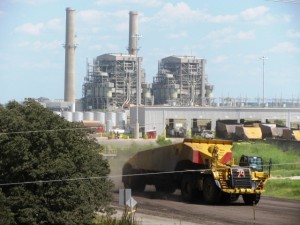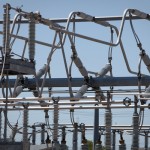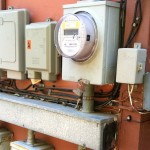Texans Use Less Power than Expected, Baffling State Regulators

Dave Fehling / StateImpact
Big Brown power plant in Freestone County
As the Texas Public Utility Commission (PUC) considers changing the electricity market so there’s more money to build new power plants, a mystery has popped up: why aren’t Texans using as much electricity as predicted?
“There’s something that’s been going on recently with the forecasts, which affects a lot of things,” said PUC commissioner Kenneth Anderson at the commission’s open meeting last week.
Who Turned the Lights Out?
Anderson said forecasts from the Electric Reliability Council of Texas (ERCOT) had predicted electricity demand would increase in 2013 by 2.1 percent.
In reality?
“It’s been barely one percent, if it’s even hit one percent,” Anderson said.
Over at ERCOT where there’s a mission-control-style room used to monitor the flow of electricity around the state moment-by-moment, analysts are scratching their heads trying to figure out why they can’t make more accurate predictions year-to-year.
“It’s really hard to piece out, we don’t have that analysis done yet,” said Warren Lasher, head of ERCOT’s systems planning.
Lasher said usually the non-farm employment numbers are a reliable indicator of how much more power will be used in homes, offices and factories. Employment in Texas is up by 2.7 percent compared to one year ago.

Photo by Filipa Rodrigues/StateImpact Texas
ERCOT's grid center in Taylor where controllers make daily forecasts of the next day’s electric demand and supply down to every five minutes.
What’s more, oil and gas exploration and production is surging, gobbling up so much electricity that there are price spikes in West Texas. In homes, there are more big screen TVs, computers, and maybe even a car plugged-in to charge overnight.
And yet, the state’s power useage has increased only half what was predicted.
It’s quite the conundrum for ERCOT’s analysts.
“There’s a lot of different things going on,” said Lasher. He said demand may have been decreased by fewer 100 degree days, higher peak prices for electricity, and customers utilizing “demand response” measures like curtailing energy use during peak times.
Lasher said ERCOT is updating its forecasting models.
“I think you’ll see those improvements when the next load forecast is released,” said Lasher.
Why Forecasting Matters
Forecasting future demand for electricity is one factor in play as Texas considers whether its energy market that was “deregulated” in 2002 is failing to attract enough investment in new power plants.

Courtesy RAP
Mike Hogan, former power company executive
“It’s way too soon to say the Texas market has been a failure. It’s probably too soon to say it’s been a success. But certainly a lot of eyes of the world are on Texas right now to see what Texas is going to do in this situation because it’s a big question that a lot of people are struggling with,” said Mike Hogan, a former power company executive now with RAP (Regulatory Assistance Project), a non-profit group that does global energy consulting.
Hogan said that Texas might not actually need to move to what’s called a “capacity market” in which fees are artificially imposed on the price of power to fund additonal generation.
“(A capacity market) is kind of like Obamacare for electricity. It’s forcing people to buy insurance they wouldn’t otherwise buy for themselves,” said Hogan in an interview with StateImpact.
He says another utility market, ISO New England, has used the capaity market concept.
“Guess what, they didn’t need new capacity. They thought they did. That’s the problem with regulators and generators. Generators always think you need more generation than you do,” said Hogan. “We might just find out Texas actually doesn’t need any new capacity, at least not right now.”
Hogan advocates what’s called a “capability market” that he describes as a capacity market that values more than just raw power generation.
The PUC has scheduled a workshop meeting October 8th to hear more from experts about ways to maintain enough generation capacity to cover the state’s expected electricity needs but at “economically optimal” cost.

